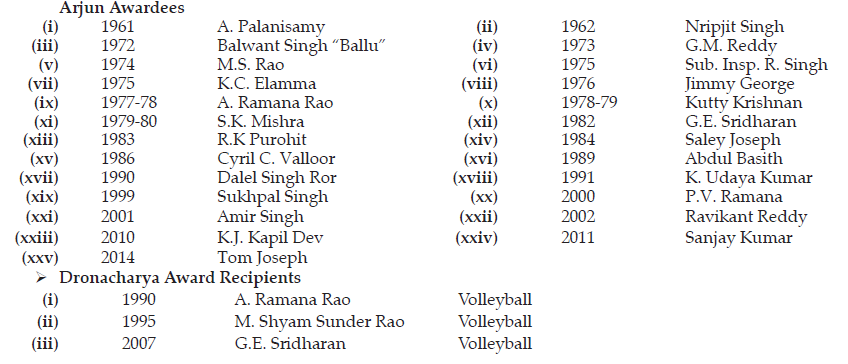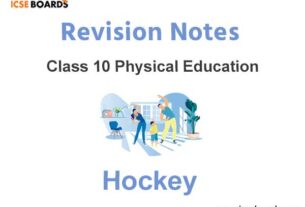Please refer to Physical Education Class 10 ICSE Volleyball notes provided below. These revision notes have been prepared based on the latest syllabus and examination pattern for ICSE Class 10 Physical Education issued for the current academic year. Students should always revise these revision notes prior to their exams to properly prepare and understand all topics. After reading these notes also refer to Sample Papers for Class 10 ICSE Physical Education
ICSE Class 10 Physical Education Volleyball Revision Notes
Students can refer to the quick revision notes prepared for Chapter Volleyball in Class 10 ICSE. These notes will be really helpful for the students giving the Physical Education exam in ICSE Class 10. Our teachers have prepared these concept notes based on the latest ICSE syllabus and ICSE books issued for the current academic year. Please refer to Chapter wise notes for ICSE Class 10 Physical Education provided on our website.
Physical Education Class 10 ICSE Volleyball Notes
➢ History
Volleyball has come a long way from the dusty-old YMCA gymnasium of Holyoke, Massachusetts, USA, where the visionary William G. Morgan (1870-1942), who was born in the state of New York, has gone down in history as the inventor of the game of volleyball, back in 1895, to which he originally gave the name “Mintonette”. Volleyball is now one of the big five international sports, and the FIVE, with its 220 affiliated national federations, is the largest international sporting federation in the world.
After seeing the demonstration, and hearing the explanation of Morgan, Professor Alfred T. Halstead called attention to the action, or the act phase, of the ball’s flight, and proposed that the name “Mintonette” be replaced by “Volley Ball.”
By 1913, the development of volleyball on the Asian continent was assured as, in that year, the game was included in the programme of the first Far-Eastern Games, organized in Manila. It should be noted that, for a long time, volleyball was played in Asia according to the “Brown” rules which, among other things, used 16 players (to enable a greater participation in matches).
Volleyball has witnessed unprecedented growth over the last two decades. With the great success of world competitions such as the FIVE World Championships, the FIVE World League, the FIVE World Grand Prix, the FIVE World Cup and the FWB Grand Champions Cup as well as the Olympic Games, the level of participation at all levels internationally continues to grow exponentially. Volleyball thus became more and more a competitive sport with high physical and technical performance.
The beach volleyball phenomenon also continues to amaze. The overwhelming spectator and television success of beach volleyball since its introduction in the Olympic Games at Atlanta 1996 and the stunning success of the FIVE World Tour, the World Championships and the Continental Cup have opened up volleyball to a completely new market.
➢ Basic Rules
* Volleyball is played by two teams of six players on a court divided by a net.

* The object of the game is to send the ball over the net so that the opposing team cannot return the ball or prevent it from hitting the ground in their court.
* Each team has three hits to attempt to return the ball.
* The ball is put in play by a serve that is hit by the server over the net to the opponent.
* When the receiving team wins a volley, it gains a point and the right to serve, and the players rotate one position clockwise.
* When the serving team wins a volley, it wins a point and the right to continue serving. « The ball must clear the net on a serve.
* A game is played to 25 points. The team that wins the best three out of five games wins the match.
➢ Volleyball Skills
(i) Serving : Serving is the first weapon that can generate an immediate point, begin a game, or ignite an offense. A well-placed serve (whether to a weak passer, at the setter, at the quick attacker, or to a weak formation) that is also difficult to pass puts the opponent at a disadvantage. Focus on correct technique and strive for success. In addition, always serve to score points, NOT just to get the ball into the opponent’s court.
(ii) Passing (Forearm Underhand) : Accurate and consistent passing can result in an aggressive multiple attacks. Be sure that players are in the ready position preparing to execute the proper technique before the serve and during a rally. The athlete must face and focus on the oncoming ball. Ensure that the athlete’s arms and hands are in the correct position with wrists together. The legs are a little further than shoulder width apart with feet parallel. The ball is contacted on the forearms. Upon contact, the athlete maintains a stationary straight arm position so that the ball rebounds off the lower part of the forearms and is directed to the target. The knees are extended to raise the arms forward upon contact. Straightening the legs completes the pass; the arms are behind the ball, and weight is transferred in the direction of the pass.
(iii) Passing (Overhand, Overhand or Setting) : Overhead passing or setting is the next important part of the pass-set-spike sequence for a successful attack. In fact, an excellent set from a bad pass can still result in a “kill”. The athlete forms a triangle with the fingers and thumbs of both hands around the ball above the forehead (thumbs do not touch). Index fingers and thumbs form the triangle around 3 panels (18-panel ball). The elbows point slightly forward. Feet are approximately shoulder width apart with right foot slightly forward. Knees are slightly bent, and body is leaning slightly forward. Eyes are focused on the ball. The athlete receives the ball with hands on the outside of the ball. The athlete extends the knees and straightness the arms to follow-through is the desired direction.
(iv) Attack (Hitting) Options : There are several attack options that can be effectively performed in a game. An attacker should be able to hit the following: shots off the block (using the hands), high sets, low sets, sets off the net, off speed shots, tipping, and a variation of play sets including back court hitting options. Providing a great deal of practice and repetition of each will depend on the age and ability of the athletes. Ensure the fundamental technique of hitting is effective and efficient so that it can be performed at a high level during competition. With regard to spiking, the athlete must first be able to demonstrate the spiking motion when on the floor (with modified and full arm swing). Second phase is arm swing, which is started with both arms at side of body. Arms are taken straight back and then thrust forward and immediately up. Third phase includes athlete jumping and spiking. As the athlete begins to jump, her spiking arm is raised with elbow shoulder high. At the top of jump, the elbow leads as the arm is extended and wrist snaps so that the heel of the athlete’s hand contacts the ball and follows through. The athlete must land softly and be in control of the landing. This is a high jump, not a long jump. Fourth phase the athlete uses only the step-close (right- left for right banders and left-right for left handers) or step 2 and 3 of the modified spiking approach. Fifth phase includes athlete using a full approach, take-off then completing the spiking motion and landing. Right hander (start right foot in front) should take left-right-left or one step and step-close approach. Left hander (start left foot in front) should take right-left-right or one step and step-close.
(v) Blocking — Attack; Defend : A well-timed and effective block diffuses an offensive attack. The athlete is near the net, moves into position with hands up quickly. Athlete focuses on the ball and jumps vertically so that maximum height is achieved when the ball is above net and contacted. Arms are raised and extended above the head; hands are close together with fingers open; wrists are in line with arms (wrist parallel), and hands are slightly forward. A firm and straight-arm position is maintained so that the ball rebounds off hands and is not struck. If possible, athlete reaches up and over the net with arms and hands pointed in a downward position for a rebound. The athlete lands facing the net while keeping the upper body in control and knees bent to absorb the shock. Depending upon whether right side or left is blocking will determine which hand should be turned inside. ;
(vi) Defensive Skills — Rolling; Sliding : When the ball does not come directly at an athlete, it may be impossible to play the ball from a regular underhand passing standing position. The athlete still focuses on the ball and takes a step with the near foot in the direction of the oncoming ball. The body is extremely low when playing the ball. To ensure that the athlete does not hurt himself/herself, the athlete will continue the momentum and either slide or roll out of the play. The goal is to get the ball up to the target and safely return to the ready position as quickly as possible.
➢ Volleyball Terminologies
Ace : A serve not returned by the opposing team.
Attack : An attempt by the offensive team to end the rally by hitting the ball to the floor of the defensive team.
Attackers : A player who spikes or hits the ball over the net.
Block : A skill executed above the net by one or more players to prevent a spike from entering their side of the court.
Dig : A basic skill used to receive an opponents attack. (Also called a bump)
Down Ball : An attacked ball that the blockers judge as not having enough speed or good enough court position to require a block.
Foul : Any rule infraction that causes the referee to blow the whistle.
Forearm Pass : A basic skill where the ball is rebounded off the players forearms to the desired target.
Free Ball : A ball returned by the opposing team that cannot be attacked and, instead, is passed over the net.
Hit : Another term used for an attack or spike.
Kill: An attack not returned by the defense.
Overhead Pass : A basic skill where the ball is contacted above the head with both hands. It can be used on defense, serve receive and setting.
Rally : The time from the start of the serve until the play is ended by a point or side out.
Rally Scoring : An alternative scoring system incorporated in the deciding game of a match where a point is scored when either team wins the rally.
Rotation : When a team earns a side out, the team moves one position clockwise on the court before the next serve.
Serve : A basic volleyball skill used to put the ball into play.
Set: An overhead pass directed to an attacker.
Side out : When the serving team loses the rally and the receiving team gets the ball and the next serve attempt. (Does not result in a point unless rally scoring is being used.)
Spikes : A powerful attack that incorporates jumping and hitting the ball into the opponents court with one hand.
Sprawl : A defensive technique used to retrieve a ball in front of the defender.
Tip : An off speed shot used by the attacker directed at the holes in the defense. Also called a dump or dink.
➢ Important Tournaments
International National
(i) Olympics (i) Federation Cup
(ii) World Championship (ii) Senior National Championship
(iii) Asian Games (iii) Junior (U-18) National Championship
(iv) American Championship (iv) Youth (U-16) National Championship
(v) Asia Championship (v) Sub Junior (U-13) National Championship
(vi) Africa Championship
➢ Awardees




